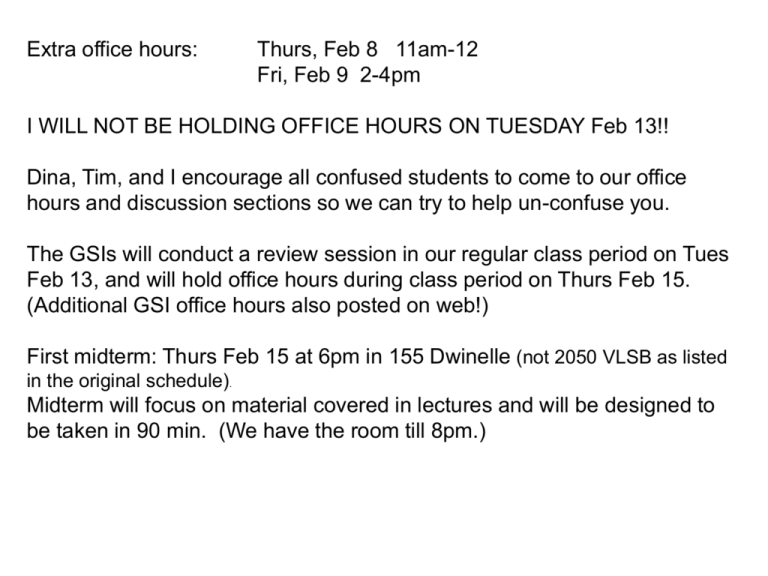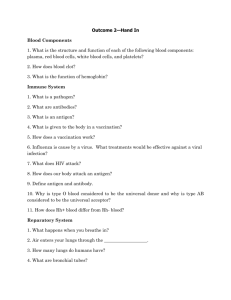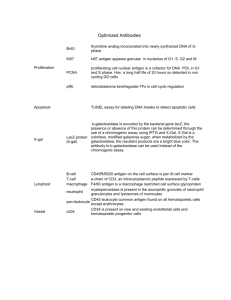B cell collaboration - Molecular and Cell Biology
advertisement

Extra office hours: Thurs, Feb 8 11am-12 Fri, Feb 9 2-4pm I WILL NOT BE HOLDING OFFICE HOURS ON TUESDAY Feb 13!! Dina, Tim, and I encourage all confused students to come to our office hours and discussion sections so we can try to help un-confuse you. The GSIs will conduct a review session in our regular class period on Tues Feb 13, and will hold office hours during class period on Thurs Feb 15. (Additional GSI office hours also posted on web!) First midterm: Thurs Feb 15 at 6pm in 155 Dwinelle (not 2050 VLSB as listed in the original schedule). Midterm will focus on material covered in lectures and will be designed to be taken in 90 min. (We have the room till 8pm.) B cell development (antigen dependent) Organization of lymphoid organs T-independent B cell activation T cell - B cell collaboration Class switch recombination and somatic hypermutation Affinity maturation and memory B cells T cell dependent and independent B cell responses 2 signal model: engagement of antigen receptor (BCR, “signal 1”) is not sufficient to activate B cell. Also need co-stimulatory signal (“signal 2”). T cell independent responses • • • • • • Simple, repetitive antigens (often carbohydrates) Mostly IgM Modest affinity No memory B cells activated by direct BCR crosslinking B cells can also be activated via Toll-like receptors (TLRs) T-independent antigen activate B cells by direct BCR aggregation Signal transduction by BCR Ig-a and Ig-b chains become phosphorylated on tyrosine residues, and then act as docking sites for other proteins, including tyrosine kinases. Assembly of large multiprotein complex: “signalosome” Signal transduction by BCR can be modulated by co-receptors. B cell development (antigen dependent) Organization of lymphoid organs T-independent B cell activation T cell - B cell collaboration Class switch recombination and somatic hypermutation Affinity maturation and memory B cells T cell - B cell collaboration •Required for antibody response to complex antigens-- proteins, lipids •Requires direct, physical B-T interaction •Involves multiple cell surface receptors on T and B cells •Both B and T cell must recognize antigen (but not necessarily the same epitope). •Both B and T cells need signal 1 (through antigen receptor) and signal 2 (co-stimulation) T cell dependent B cell response •Sequence of events: •Antigen binding to BCR provides “Signal 1” to B cell. •Antigen is internalized, processed and antigenic peptides are displayed on MHC for T cell recognition. •TH (helper T cell) recognizes antigen-MHC complex via the T cell antigen receptor (TCR): provides “Signal 1” to T cell. •B7 on B cell binding to CD28 on T cell provides “Signal 2” to T cell. •T cell activation leads to up-regulation of CD40L which bind to CD40 providing “Signal 2” to B cell. •Cytokine production by activated T cell also help to activate B cell. •B cell proliferates and differentiates into antibody secreting B cell (plasma cell). B cells (green) interacting with T cells (red) a few hours after antigen encounter. In intact lymph node at boundary between cortex and paracortex. ~200x real-time. QuickTime™ and a Cinepak decompressor are needed to see this picture. QuickTime™ and a Cinepak decompressor are needed to see this picture. From Okada et al, PLoS Biology 2005 e150 Videos 5 and 6 Antigen recognition by B cells vs. T cells Both form their antigen receptors by V(D)J recombination B cell receptor (BCR) consists of 2 HC and 2 LC (membrane Ig). T cell receptor (TCR) consists of ab heterodimer (membrane form only). Both signal by associating with signaling complex in membrane: Ig-a and Ig-b for B cells, CD3 complex for T cells. B cells can bind intact protein antigen in solution. T cells bind peptides displayed on the surface of another cell : an “antigen presenting cell” (dendritic cell, macrophage, or B cell). B cell development (antigen dependent) T-independent B cell activation T cell - B cell collaboration Class switch recombination Somatic hypermutation, affinity maturation and memory B cells And review (if we have time) Antigen encounter drives B cell maturation “Naïve” B cell (IgM, IgD membrane Form only) Antigen encounter drives B cell maturation Proliferation Antibody secretion Class switch “Naïve” B cell (IgM, IgD membrane Form only) Antigen encounter drives B cell maturation Proliferation Antibody secretion Class switch “Naïve” B cell (IgM, IgD membrane Form only) “Activated” B cell (secreted IgM and other isotypes: IgA, IgG, IgE) V(D)J Rearrangement VH gene segments First 96 aa’s of Ig HC DH gene segments 3-6 aa’s HC JH gene segments 10-12 aa’s HC CH exons Gene rearrangement Variable domain exon Constant domain exons Relationship between Heavy-chain isotypes and constant regions in HC DNA Antibody Isotypes HC locus constant exons Note: Isotype names are called: M, D, G,A, E. Constant regions exons are called by corresponding greek symbols: a How can a B cell clone produce antibodies with the identical antigen binding site but different constant regions? Alternate mRNA processing: For secreted vs membrane Ig and for IgM vs IgD. Class Switch recombination: For IgG, IgA, IgE Ig heavy-chain gene promoter enhancer S V Leader exon DJ J J Variable domain exon CH1 CH2 CH3 Constant domain exons CH4 M1 M2 Membrane associated vs. secreted Ig: Differential mRNA splicing Ig heavy-chain gene Switch promoter enhancer sequence S V DJ J J CH1 CH2 CH3 M1 M2 CH4 Leader exon V DJ CH1CH2CH3CH4 Secreted form mRNA V DJ CH1CH2CH3CH4 Membrane-associated form mRNA Note: mRNA processing, not DNA recombination is occurring. Both secreted and membrane forms of Ig HC can be made by the same B cell. Membrane associated vs. secreted Ig: Differential mRNA splicing Expression of IgD: Regulated transcriptional termination & RNA splicing AAAAAA V DJ J J V CH1 CH2 CH3 CH4 C1 chain exons C2 C3 C4 chain exons DJ CH1CH2CH3CH4 AAAAAA V DJ J J CH1 CH2 V C1 CH3 CH4 DJ C2 C3 C4 C1 C2 C3 C4 Note: mRNA processing, not DNA recombination is occurring. Both IgM and IgD can be made by the same B cell. Other Ig isotypes (IgG, IgA, IgE) are generated by a second type of somatic DNA recombination called Class-Switch Recombination (CSR) A“Switch site” located 5’ to each CH segment targets the recombination machinery. Note: DNA recombination is occurring. Once a B cell has switched to make IgG, it can no longer make IgM. (However, its siblings can.) Heavy-chain isotypes-- same variable domain, different constant domains Activities involved in CSR • DOES NOT require RAG1 or RAG2 • Does require Ku70, Ku80, & DNA-PK • Requires at least part of each “switch sequence” How can a B cell clone produce antibodies with the identical antigen binding site but different constant regions? Alternate mRNA processing: secreted vs membrane Ig and for IgM vs IgD. Same B cell can simultaneously produce sIg, mIg, IgM and IgD. Class Switch recombination: IgG, IgA, IgE Progeny of single B cell can produce different isotypes. Comparison of V(D)J recombination and class switch recombination (CSR) • V(D)J recombination occurs as part of antigen-independent development in primary lymphoid organs (bone marrow). CSR occurs as part of antigen-dependent development in secondary lymphoid organs (lymph node, spleen). • V(D)J requires RAG1 or RAG2. CSR does not. • V(D)J recombination is targeted precisely (RSS). CSR occurs within simple repetitive DNA sequence (switch sequence). • Both require Ku70, Ku80, & DNA-PK (dsDNA repair pathway). Cytokines (interleukins) direct class switching. T cells can determine the type of Ig produced by a B cells by the type of cytokines they secrete. B cell development (antigen dependent) Organization of lymphoid organs T-independent B cell activation T cell - B cell collaboration Class switch recombination Affinity maturation, somatic hypermutation and memory B cells Affinity maturation: the increase in the average affinity of an antisera that occurs during the course of an immune response or with successive immunizations 1st immunization 2nd 3rd 10 Average Affinity (log scale) 5 Time (weeks) Affinity maturation correlates with Somatic Hypermutation (SHM). Antibodies produced late in an immune response have point mutations clustered within CDR regions. Sequence alignments of IgG isolated from B cells late in an immune response. Red bars show positions in which nucleotides differ from those found in germline gene DNA segments. Somatic hypermutation (SHM) increases progressively during the course of an immune response and correlates with increased affinity for antigen (Note, higher affinity corresponds to a lower Kd.) The distribution of mutations is limited by the V gene promoter and the intronic enhancer The mutation rate within this region is 106 times greater that the normal mutation rate for other genes. Why do Ig genes of activated B cells show such a high rate of mutation? How does this increased mutation rate lead to increase antibody affinity? Link between DNA repair and somatic hypermutation: Error-prone repair dsDNA break Mutation introduced during DNA repair Rate= 1 mutation per 1000nt per cell division (normal mutation rate is 1 per 100,000,000) Mechanism not fully understood, but requires the enzyme: Activation-induced cytidine deaminase (AID) Mice with targeted mutation of the AID gene can produce IgM but not other isotypes (defective in class switching) (Honjo and colleagues 2000) Mice with targeted mutation of the AID gene are also defective for somatic hypermutation (Honjo and colleagues 2000) Affinity maturation occurs because of somatic hypermutation and B cell selection in the germinal center Mechanism that generates mutations does not discriminate between mutations that increase or decrease affinity. Yet, SHM eventually leads to the generation of antibodies with higher affinity. The key to this paradox is cellular selection. Somatic mutation: Evolution in “real time” • Occurs within germinal centers of secondary lymphoid organs. • Hypermutation mechanism generates point mutants in variable domains • B cells undergoing rapid cell division • B cells tested for ability to bind to antigen displayed on follicular dendritic cells • B cells with best affinity divide more often • B cells which can’t compete die by apoptosis Note: follicular dendritic cells are NOT related to the dendritic cells (DC) that we discussed in earlier lectures. FDC are stromal cells, not blood cells, are not major mediators of innate immunity, and do not present antigens to T cells. Cellular events in germinal centers: Follicular dendritic cells present antigen to germinal center B cells in form of antibody-antigen complexes. B cells with highest affinity antibodies compete more effectively for survival signals from follicular dendritic cells. Selected B cells give rise to high affinity plasma cells and memory B cells. Activated B cells (green) migrating in germinal center. Naïve T and B cells (red) are shown for comparison. ~200x real-time. QuickTime™ and a YUV420 codec decompressor are needed to see this picture. From Allen et al, Science 2007 v315 (5811) p528 Video 2 The phenomenon of B Cell Memory Due to presence of “memory B cells” the progeny of B cells that responded to antigen in primary immunization. B cell memory can persist for life. Correlates with higher frequency of specific B cells, and higher affinity of antibodies. Mechanism that generates and maintains B cell memory? persistence of antigen, longevity of memory B cells? Human genetic immunodeficiency illustrate the importance of memory B cell responses: X-linked hyper-IgM syndrome: Patients lack CD40L on T cells. Defective memory B cell response lack germinal centers low affinity antibodies suseptible to opportunistic pathogens Hyper IgM syndrome 2 mutation in AID failure to undergo somatic hypermutation increased suseptibility to bacterial infection Agglutination as a clinical assay-- Testing for Rh incompatibility Disease: Erythroblastosis fetalis Cause: Mother produces IgG that bind to an antigen (Rh) on RBC of fetus Detection: Expose RBC to anti-human Ab and look for agglutination Exposure to fetal blood cells during first pregnancy can induce a memory B cell response to the Rh antigen. Treatment of mothers with antibodies to Rh (RhoGam) at time of 1st delivery can prevent her from developing anti-Rh antibodies. Genetic Events in Ig Gene Expression • V(D)J recombination* • Transcription • Regulated polyadenylation and RNA splicing • Class switch recombination* • Somatic hypermutation* • * these involve alterations in the antibody genes B-cell Development and Human Tumors Antigen Independent Antigen Dependent Pro-B Leukemia Ig genes are markers of stage Transloc/activ of non-Ig genes Pre-B Mature B Plasma Cell Lymphoma Plasmacytoma Bcl-2 to Ig rearr. c-myc to Ig rearr. Myc-Ig rearr DNA rearrangements that occur during VDJ recombination and class switching can activate proto-oncogenes Review A a result of V(D)J recombination every mature B cell expresses a unique antibody. Encounter with an antigen leads to clonal expansion of B cells with a particular specificity. B Cell Development Antigen-independent phase (bone marrow, fetal liver) Antigendependent phase (spleen, lymph node) Molecular events V(D)J rearrangement Class switch, Somatic hypermutation Cellular events proB > preB > mature B cell development B cell activation, Memory and plasma B cell differentiation B cell development The preB cell Ordered gene rearrangements A model for allelic exclusion The role of the preBCR in B cell development B cell tolerance Tolerance to self involves both B and T cells and operates at early and late stages of B cell development • There are many overlapping mechanisms that ensure self-tolerance. • Self-reactive B and T cells are eliminated or inactivated during their development • Most B cell responses depend on T cell help, so T cell tolerance helps to ensure that antibodies against self are not generated. • B cell-intrinsic tolerance mechanisms are especially important for T-independent B cell responses. • Somatic hyper-mutation can potentially generate new self-reactive specificities after B cells encounter antigen. How does a B cell know if an antigen is self or foreign? • Timing: Antigens that are encountered soon after IgM expressing B cells first arise in the primary lymphoid organs tend to induce tolerance. • Presence of co-stimulatory signal: Antigens that are encountered in the absence of co-stimulatory signals (signal 1, but not signal 2) tend to induce tolerance. • (Note that co-stimulatory signals are directly or indirectly produced by innate immune responses!) B cell tolerance • Clonal deletion-- the removal, by apoptosis, of B cells with self-specific antigen receptors • Anergy-- the biochemical inactivation of self-specific B cells • Receptor editing-- ongoing V(D)J recombination resulting in light-chain replacement and escape from self-reactivity • Ignorance-- self-specific B cells are present and functional, but levels are self proteins are insufficient to trigger autoimmunity. Immature vs. mature B cells •IgMlo IgDneg •BCR crosslinking leads to apoptosis, not activation •Subject to “receptor editing” as a selftolerance mechanism Receptor Editing: an important mechanism of B cell self-tolerance receptor editing Vk Vk Jk Jk Jk Upstream Vk to downstream Jk rearrangement deletes pre-existing light chain gene. Using rearranged Ig transgenic mice to study B cell tolerance VDJH exons VJk exons CH exons Ck exons Rearranged HC and LC chain cloned from a mature B cell and introduced into the germline via transgenesis to create an Ig transgenic mouse line. The majority of B cells developing in these mice express a single, defined Ig. A transgenic model of B cell tolerance Anti-HEL Ig transgenic HEL-expressing transgenic X HEL= Hen Egg Lysozyme (not exactly self, but acts as a self antigen when expressed as a transgene.) Double transgenic Soluble, secreted HEL Anergy (self-reactive B cells are present but non-functional.) Membrane-associated HEL Clonal Deletion (Ig expressing B cells are removed) B Cell Tolerance: Evidence for Clonal Anergy Anergy: B cells expressing self-reactive Ig are present but are abnormal and nonfunctional. B cells from anti-HEL transgenics can secrete anti-HEL Ig when stimulated. B cells from double transgenic mice cannot. Genetic Events in Ig Gene Expression • V(D)J recombination* • Transcription • Regulated polyadenylation and RNA splicing • Class switch recombination* • Somatic hypermutation* • * these involve alterations in the antibody genes









